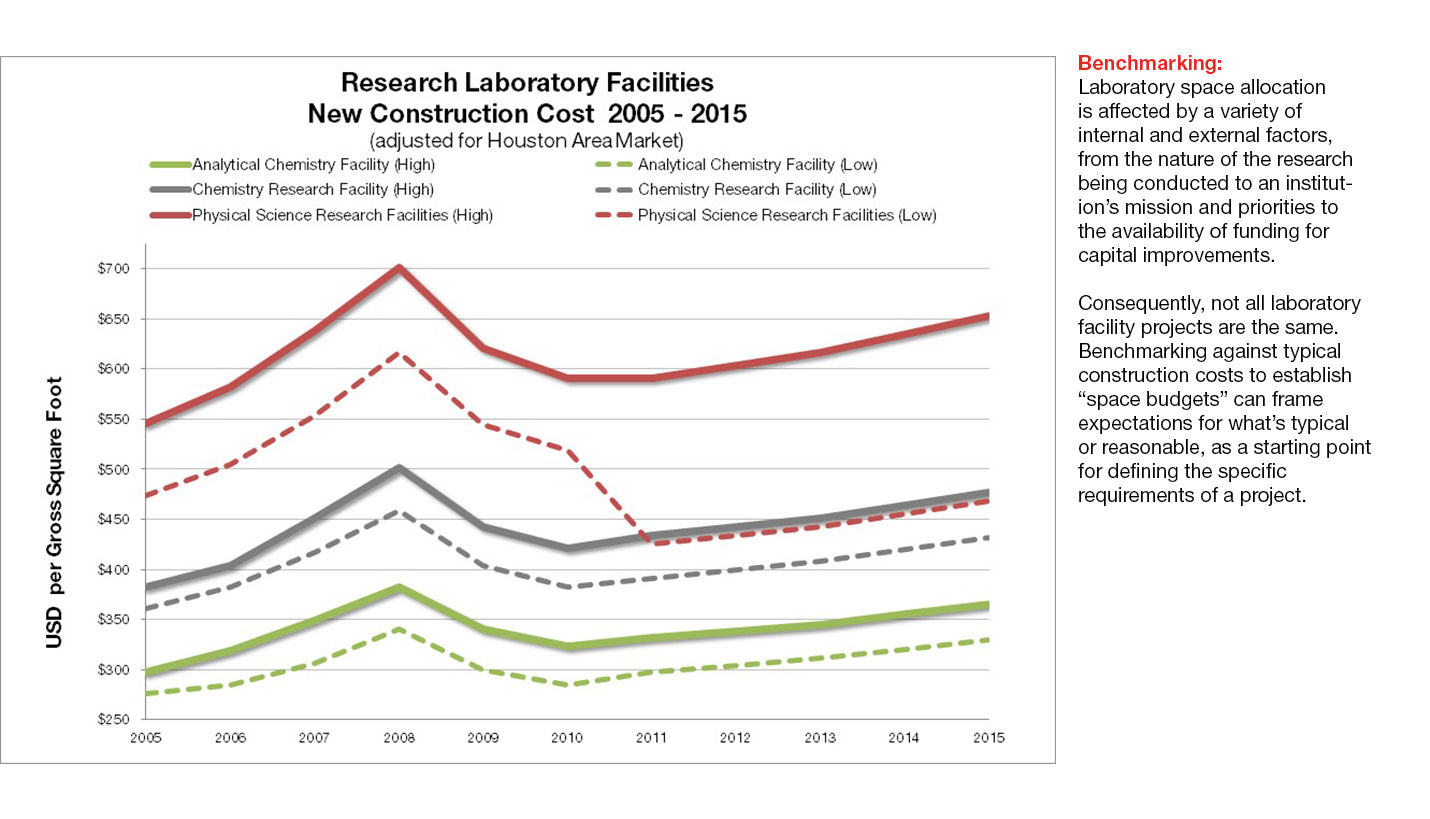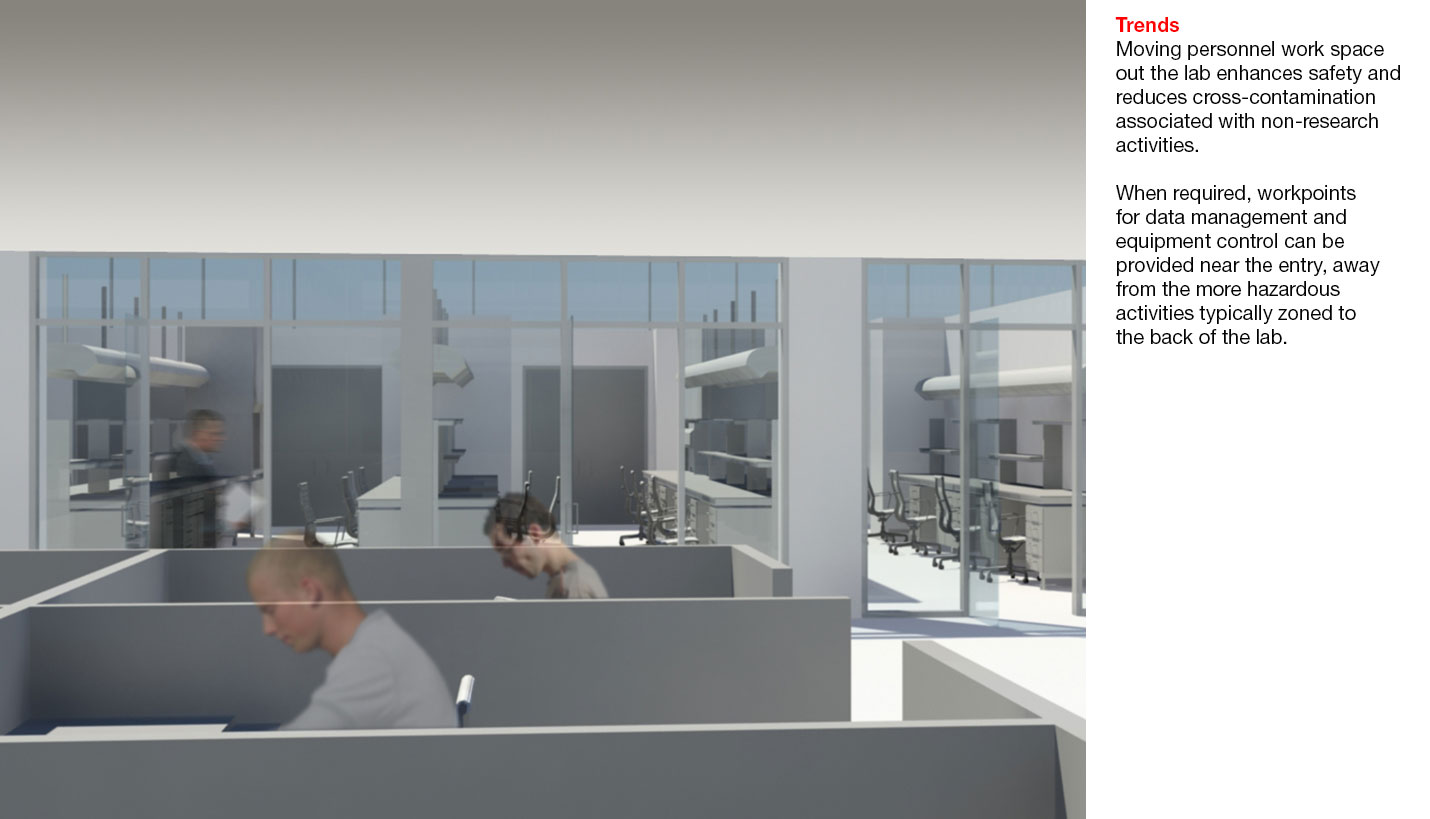Benchmarking and Trends Research: Promoting Innovation in Laboratory Design
With each new laboratory project comes the opportunity to improve upon the last—to reuse design ideas that work, rework those that do not, and uncover altogether novel concepts in the process. Often, these innovations result from an ability to tap into current modes of thinking and doing, grounded in a detailed understanding of precedents. In short, the key to developing effective laboratory design solutions is a robust knowledge base informed by an examination of industry trends and salient characteristics of peer institutions—or benchmarks.
Tracking data like cost per square foot, building (space) efficiency, area per principal investigator, module size, and lab area utilization can provide useful metrics for formulating facility programs and conceptualizing and evaluating designs, especially when specific information is not available from lab users. Often, these statistics can be drawn from a firm’s project database. There are also a number of free and subscription on-line resources like Animal Lab News, Design Cost Data, Engineering News-Record, Lab Design News, and Tradeline that provide an abundance of useful information.
In recent years, the changing nature of research and scientific experimentation has resulted in key shifts in the way laboratory facilities are being planned. Based on the recognition that today’s research problems are often multi-faceted, a team-based approach that brings together specialists from different fields to devise solutions is replacing the traditional model of the lone principal investigator operating in a disciplinary silo. Highly flexible and technologically advanced facilities are regarded as best-suited to accommodate this collaborative research model. As a result, in the past decade, more and more labs have been planned with open layouts, movable walls, mobile furniture, overhead service distribution, plug-and-play utilities, and robust building systems and infrastructure, in lieu of traditional cellular labs with fixed benches. Other features such as daylighting, energy recovery systems, and high-performance fume hoods have also become quite common.
These changes in the research world are highlighted not only by specific design features in many recently constructed facilities, but also by the kinds of spaces and services that today’s researchers are requesting. A 2006 R&D magazine survey found six features that principal investigators identified as essential to on-going and future research efforts1:
- Ability to change / lab flexibility
- Office proximity to labs
- More lab storage space
- More meeting space
- Sustainable facilities and practices
- Bigger, better, faster communication systems to support global research partnerships
Five years later, a survey conducted by the same magazine revealed a similar set of priorities3:
- Adequate work space
- Safety features
- Functionality
- Computer/communication network
- Storage space
- Cost-efficiency in life-cycle costs
In both surveys, researchers did not report dissatisfaction with their workplace environments as long as the offices were relatively close to the labs, were large enough, and had windows, with adequate meeting space in the vicinity. Researchers also reported greater sensitivity to the environmental impact of their work and the need for resource-conserving science facilities2,4. Sustainability has become an expectation rather than an aspiration.
Laboratory designs must continue to innovate in these areas, therefore, to keep up with the evolving research landscape. These changes are increasingly rapid. Although 41% of the surveyed researchers reported working in facilities less than five years old, only one in seven described the facilities as “state-of-the-art”; and more than half claimed their facilities require upgrading3.
To get there, laboratory planners ought to look to the researchers—only 7% of whom believe planners should tell them what’s required3—as a primary source of information about their facility upgrade or expansion needs. Presenting them with data for similar, recently completed exemplars is usually a good way to start the conversation.
REFERENCES
- What Researchers Want, Research & Development Magazine, 16 May 2006.
- Design teams, users weigh in on lab design trends, Lab Design News, 15 June 2010.
- Better Times, Better Labs?, Research & Development Magazine, 18 Oct. 2011.
- Sustainable Laboratory Design and Construction: Sustainability Basics and Design, Research & Development Magazine, 5 June 2014.
Contributed By
Verrick D. Walker PhD, LEED AP, CDT
01/25/2016
People
Related Posts
- A District Built For Health
- The Essential Steps for Bringing a Facility Project to Market Quickly
- Overview: Dell Medical School at The University of Texas at Austin Updates
- New School of Thought at New School of Medicine
- Sustainability Design Leaders Tour Dell Medical School
- Dell Medical School Specialty Clinics Open
- SXSWedu Announces Learn By Design Finalists















